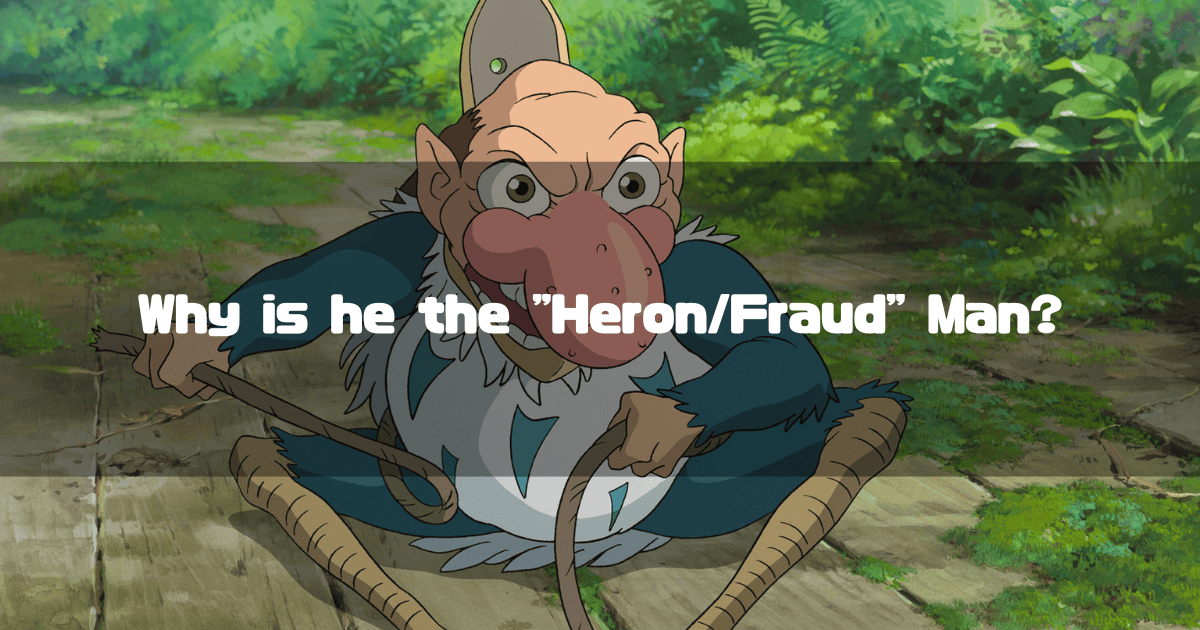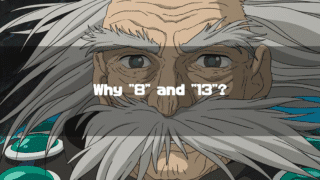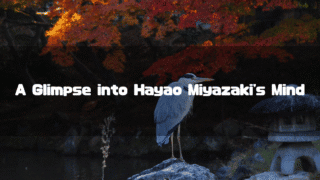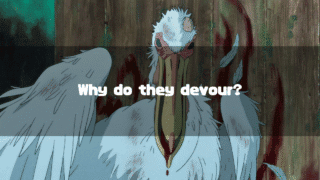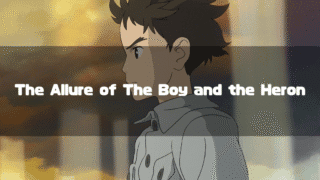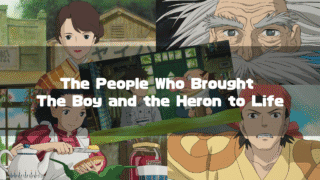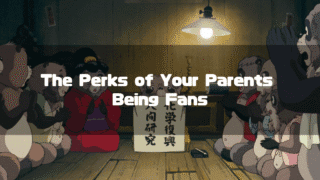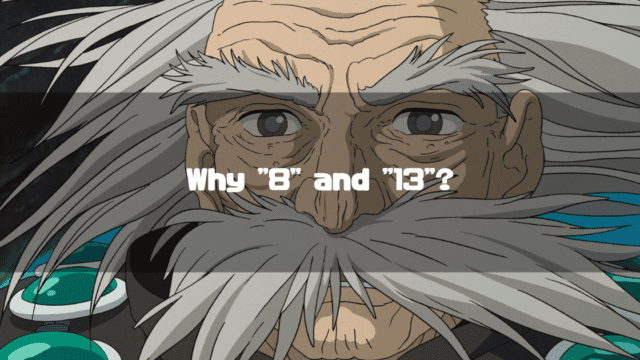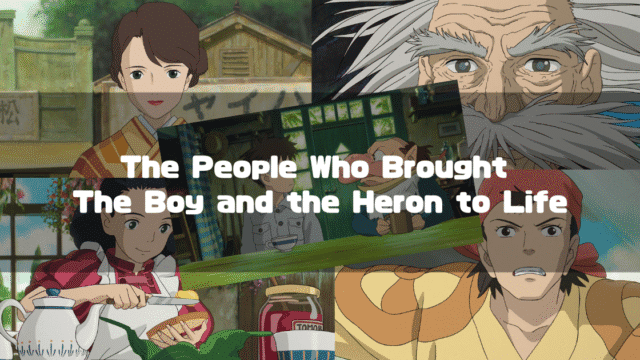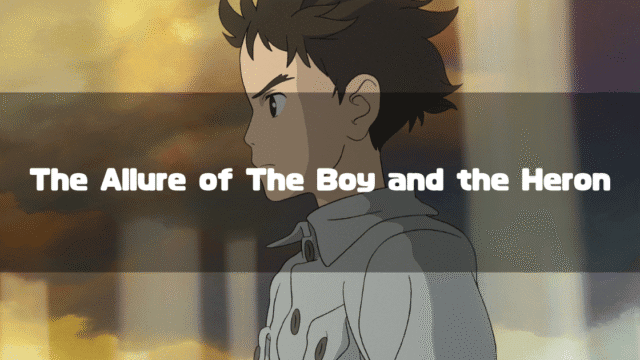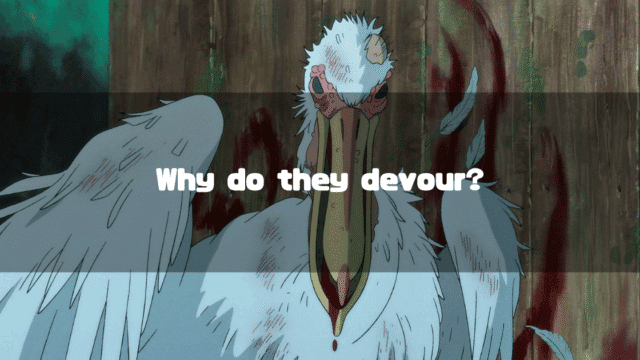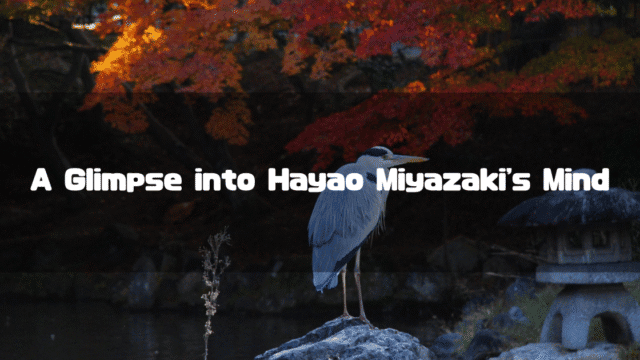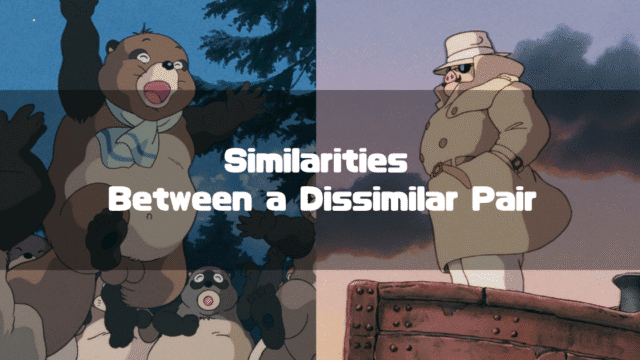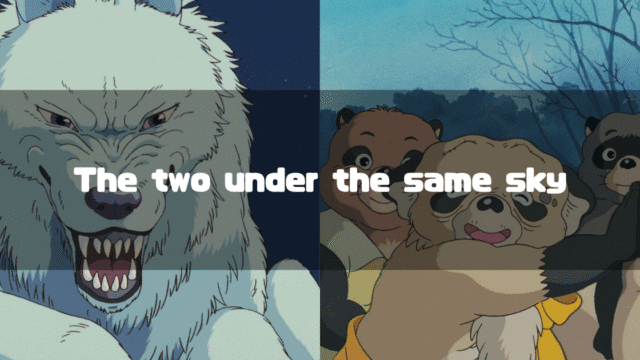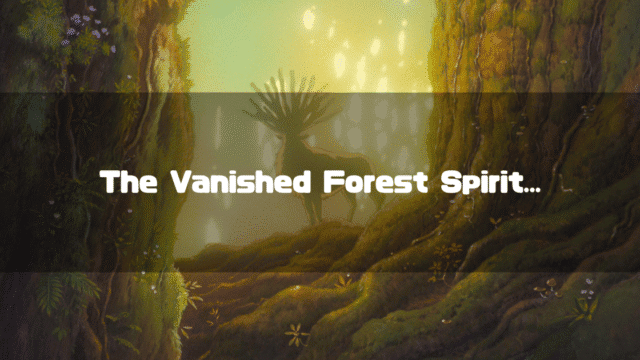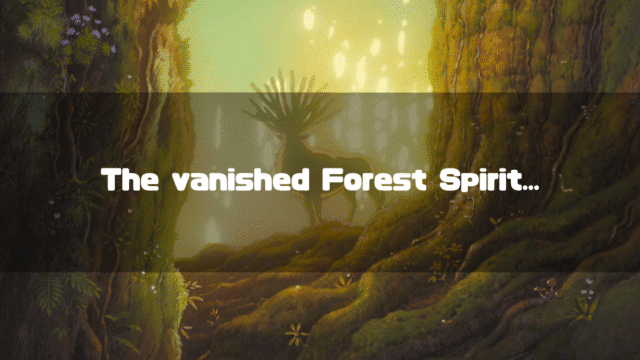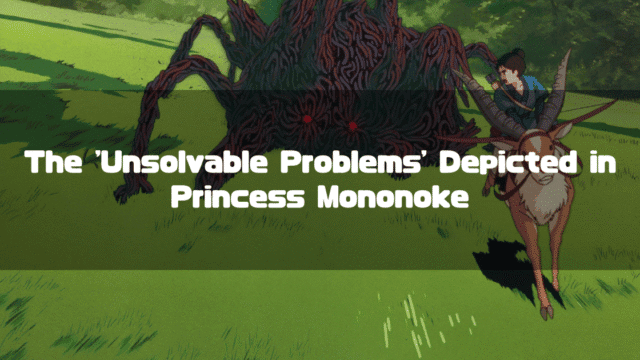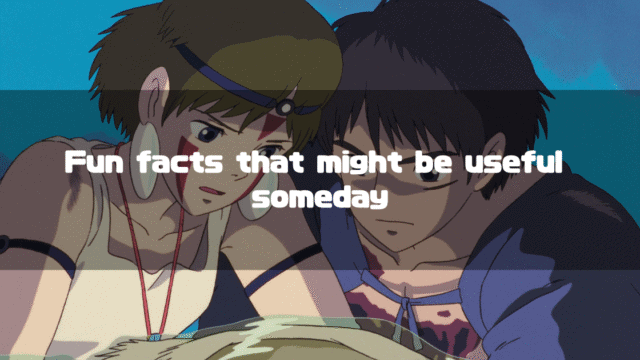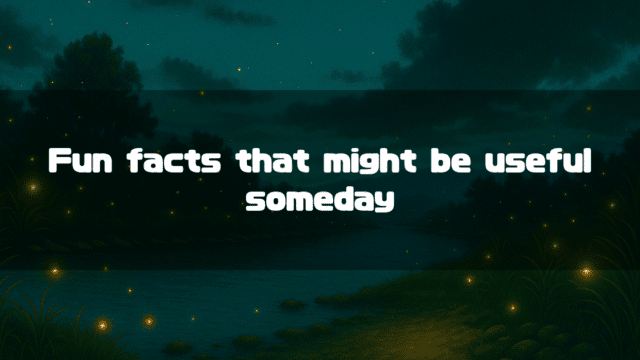The Boy and the Heron(Studio Ghibli Official) is a theatrical animated film directed by Hayao Miyazaki, released in 2023.
The Boy and the Heron is an autobiographical work by Hayao Miyazaki, and many of its characters are based on real people (Kiriko is based on Michiyo Yasuda, the Granduncle on director Isao Takahata, etc.). This time, by looking back at the history of producer Toshio Suzuki’s masterful skills, who became the model for the Gray Heron or the Heron Man, I hope to convince you that “Indeed, Toshio Suzuki is a ‘Heron/Fraud’ man.“
A Quick Note on a Japanese Pun
To fully appreciate the theme of this article, it helps to understand a clever play on words in Japanese. The Japanese word for “heron” is sagi (サギ).
This same sound, sagi, is also the word for “fraud” or “swindler” (詐欺). Therefore, calling producer Toshio Suzuki the “Heron Man” (Sagi Otoko) is a pun suggesting he is not only the model for the bird but also a masterful “swindler” in a business sense, known for his bold and cunning strategies that helped build Studio Ghibli.
The fact that Toshio Suzuki is the model for the Gray Heron (Heron Man) has been mentioned in various media, including the production documentary Hayao Miyazaki and the Gray Heron and…(宮崎駿と青サギと…, in Japanese). In an interview in SWITCH Vol.41 No.9 Special Feature: The Adventure Surrounding Ghibli(SWITCH Vol.41 No.9 特集 ジブリをめぐる冒険, in Japanese), Toshio Suzuki also stated the following:
Anyone can see that the Heron Man is me. So, what’s drawn is drawn, and the question was how to tell Miya-san about it. I had no choice but to say, “Miya-san, the Heron Man is a great character, isn’t he?” When I asked, “Is there a model for him?” Miya-san replied, “No!” The way he said it was incredible. “No, no. There isn’t! It’s not you, Suzuki-san!” That’s Hayao Miyazaki for you.
(Original Text in Japanese)
サギ男は誰がどう見たって僕なわけですよ。それでね、描いてしまったものはしょうがない、どうやって宮さんに言うかですよね。もう仕方なく「宮さん、サギ男って良いキャラクターですよね」と言った。「モデルがいるんですか?」と訊ねると「いないよ!」と宮さんは答えた。そのもの言い、すごかったですよ。「いない、いない。いないよ!鈴木さんじゃないよ!」と。これがね、宮崎駿なんです。
Indeed, his appearance in the film, luring Mahito into the tower, is reminiscent of Toshio Suzuki persuading Hayao Miyazaki to make films. His act of saving Mahito from being eaten by the parakeets and getting covered in muddy water can be seen as a projection of “Toshio Suzuki protecting Hayao Miyazaki as a creator from public criticism and money-grubbers.”
However, running Studio Ghibli and working with brilliant creators like Hayao Miyazaki and Isao Takahata is no small feat, and it requires extraordinary decisions.
This time, I will introduce some of those “decisions” that could almost be called “frauds.” Just from the anecdotes introduced in the following text, you might be convinced why Toshio Suzuki appeared as the Heron Man.
*This article is an English translation of the original Japanese article, 【君たちはどう生きるか】青サギ(サギ男)のモデルとなった鈴木敏夫のおもしろ「サギ」列伝-スタジオジブリを支えた辣腕の歴史-.
Let an AI walk you through the highlights of this post in a simple, conversational style.
-
Toshio Suzuki’s “Fraud Legends” – Ghibli’s History Supported by Bold Lies and Forceful Measures
A look back at a series of “bluffs” by Toshio Suzuki to make box office and production successful, including false reports of 500,000 copies of Nausicaä, unmentioned uncolored scenes, posters with fake release dates, and forcing through a title. -
The Spirited Away DVD Red Tint Controversy – The Aftermath of a Color Tone Change Called a “Specification”
The reddish video on the 2002 DVD was officially explained as “expressing Chihiro’s feelings,” and no exchanges were offered, leading to viewer confusion and lawsuits.
- The Amusing “Fraud” Legends of Toshio Suzuki, the Model for the Gray Heron (Heron Man)
- The Big Lie That the Original Nausicaä of the Valley of the Wind Manga Sold 500,000 Copies
- If You Don’t Have Money, Just Make a Movie – The Beginning of Hayao Miyazaki’s Infinite Hell
- It’s Not Unfinished, It’s Artistic Direction – The Bluff Regarding Uncolored Scenes in Grave of the Fireflies –
- Creating a Poster Just to Deceive Isao Takahata – A Clever Trick to Defend the Release Date –
- Releasing the Title Princess Mononoke Without Permission – The Lost The Tale of Ashitaka –
- An Attempted “Fraud” in the End Credits of Tales from Earthsea
- The Spirited Away DVD Color Tone Problem – That Summer, You Were Red –
The Amusing “Fraud” Legends of Toshio Suzuki, the Model for the Gray Heron (Heron Man)
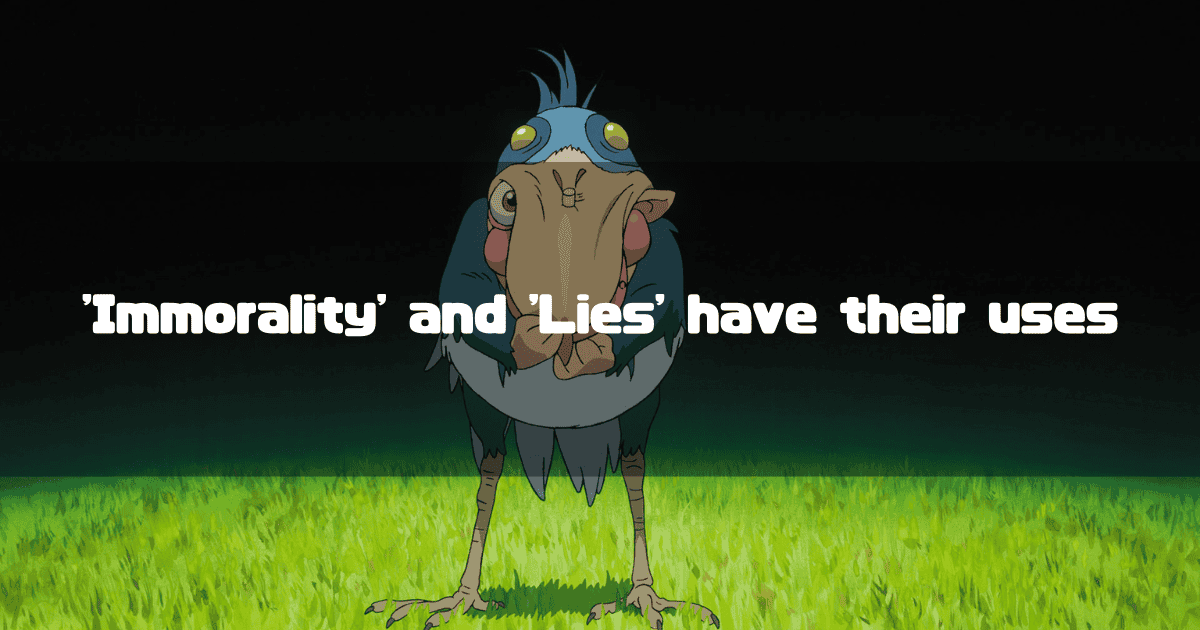
The Big Lie That the Original Nausicaä of the Valley of the Wind Manga Sold 500,000 Copies
Toshio Suzuki joined Tokuma Shoten in 1972 after graduating from university. He was initially assigned to “Weekly Asahi Geino,” but from the spring of 1978, he became deeply involved in the launch of “Animage.”
At that time, he requested an interview with Isao Takahata, who had directed The Great Adventure of Horus, Prince of the Sun (1968), but was turned down after an hour-long explanation over the phone. Hayao Miyazaki, who took the phone next, also refused him over a 30-minute conversation. It was a tough start, but this became their fateful first contact.
Afterward, through interviews for Lupin the 3rd: The Castle of Cagliostro and Chie the Brat, Toshio Suzuki deepened his friendship with Hayao Miyazaki and Isao Takahata.
If You Need an Original Story, Just Make One
In response to a call from Yasuyoshi Tokuma, the president of Tokuma Shoten, Toshio Suzuki consulted with Hayao Miyazaki in 1981 and proposed a film project titled “Sengoku Majo” (Warring States Demon Castle), but unfortunately, it was rejected.
The reason for the rejection was that it “lacked an original story.” At the project meeting, someone from Daiei (a film company in the Tokuma Group) said, “A film without an original story can’t be a hit.” When Suzuki told this to Miyazaki, he responded, “Then let’s just draw the original story,” and thus began the creation of the manga Nausicaä of the Valley of the Wind (serialized in “Animage”).
This part is also amazing. I would probably try to find an original story rather than create one, but the decision to “create something that doesn’t exist” was crucial. It might also have been that Hayao Miyazaki wanted to draw a manga.
The 500,000-Copy Lie That Sealed the Nausicaä Movie Deal
As mentioned above, the “let’s just make the original story” plan began, but of course, just having an original story isn’t enough. When considering the “box office,” it’s natural to think about how popular that original story is.
In his book Shigoto Doraku, Toshio Suzuki recounts:
When the idea of making ‘Nausicaä’ into a movie came up, Hakuhodo asked me for the number of copies of the original book. It was actually fifty thousand, but after a moment’s hesitation, I said, ‘five hundred thousand.’ The thought that they might be reluctant to make a movie with only fifty thousand copies crossed my mind. Since I clearly falsified the numbers, this kind of lie sticks with you afterward.
(Original Text in Japanese)
『ナウシカ』の映画化案が浮上したとき、博報堂から原作本の部数を聞かれた。実際は五万部だったんですが、一瞬逡巡して「五〇万部」と言ったんです。五万部では映画化を渋るかもしれないという考えが頭をよぎったんです。はっきり数字を誤魔わしてますから、こういう嘘はあとに残る。
As a result, we were able to see the movie Nausicaä of the Valley of the Wind, meaning Toshio Suzuki’s lie brought a great benefit to us consumers.
Moreover, Nausicaä of the Valley of the Wind was a huge box office success. According to Ghibli no Nakamatachi(ジブリの仲間たち, in Japanese), its distribution revenue was 740 million yen (the total amount paid by moviegoers, minus the movie theater’s share).
Consequently, a large sum of money fell into the hands of director Hayao Miyazaki, and Toshio Suzuki was also involved in this. In Ghibli Textbook 2: Castle in the Sky(ジブリの教科書2 天空の城ラピュタ, in Japanese), Suzuki states:
Actually, when we were making ‘Nausicaä,’ I had a contract drawn up so that Hayao Miyazaki, as the director, would receive a share of the profits, including box office revenue and other things.
~Omitted (Discussion about “work for hire (wiki)”)~
As someone from a publishing company, I had respect for original works and wanted to protect that. I also knew how creators were treated, so I did a little studying and took this opportunity to establish the director’s personal copyright.
(Original Text in Japanese)
じつは『ナウシカ』を作る時、僕は宮崎駿という監督に映画の興行収入その他のものも含めて利益配分があるように契約書を作っておいた。~中略(「職務著作(wiki)」の話がなされてる)~
僕は出版社の人間だったので直鎖物に対する敬意がありそれは守りたかった。作った人がどういう扱いをされているかも知っていたので、ちょっと勉強して、この機会に監督個人の著作権を発生させることにしてあったんです。
And this large sum of money, while causing Miyazaki some distress, would lead to the creation of his next masterpiece, Castle in the Sky.
If You Don’t Have Money, Just Make a Movie – The Beginning of Hayao Miyazaki’s Infinite Hell
Hayao Miyazaki, who had unexpectedly earned a large sum of money from Nausicaä of the Valley of the Wind, decided to invest it in The Story of Yanagawa’s Canals.
The Story of Yanagawa’s Canals is a live-action documentary directed by Isao Takahata, depicting the history of the decay of the “horiwari” canals in Yanagawa City, Fukuoka Prefecture, and the desperate efforts of local residents to restore them.
However, the large sum of money he was supposed to have obtained thanks to Nausicaä of the Valley of the Wind ran out (Reference: The Story of Yanagawa’s Canals | Ji-Movie! Film Information, in Japanese).
In that situation, Hayao Miyazaki came to consult Toshio Suzuki. In Ghibli Textbook 2: Castle in the Sky, Suzuki recounts the situation as follows:
Miya-san came to me for advice.
“I’ve spent a lot of time and money, but it’s still not finished. My house is a wreck, but I don’t want to mortgage it to make a movie. Suzuki-san, do you have any ideas?”
I answered immediately.
It’s tough, but why don’t we make one more movie? That should sort things out.
(Original Text in Japanese)
宮さんが僕のところに相談に来ました。「時間もお金も費やしたけどどまだできない。僕の家はボロ家だけれど、家を抵当に入れてまで映画を作ろうとは思わない。鈴木さん、なにか知恵はないものだろうか。」
僕は即答しました。
大変だけどもう一本映画を作りませんか。そうすりゃなんとかなりますから。
In the same text, it is said, “On the spot, in just five minutes. He told me the entire story of ‘Castle in the Sky.'”
The issue here is “Why would making another movie solve the problem?” but this strange phenomenon is not limited to films.
In other words, it’s rare for a project to turn a profit with the money initially raised, so the resulting deficit will likely be covered by money raised for another project.
It sounds bad to call it “robbing Peter to pay Paul,” but that’s what business expansion is like. There’s no such thing as a constantly profitable business expansion… right?
Therefore, Toshio Suzuki’s statement cannot be called a “fraud.” However, from the perspective of leading Hayao Miyazaki into an infinite hell of film production, it can be called a “scam.” The image of the Gray Heron in The Boy and the Heron leading Mahito to the “Granduncle’s Tower” surely overlaps with the image of Toshio Suzuki saying to Hayao Miyazaki, “Why don’t we make one more movie?”
It’s Not Unfinished, It’s Artistic Direction – The Bluff Regarding Uncolored Scenes in Grave of the Fireflies –
Leaping forward in time a bit, Studio Ghibli has been established, and Castle in the Sky has been released.
At Ghibli, production was underway for My Neighbor Totoro and Grave of the Fireflies.
However, the production of Grave of the Fireflies was progressing very slowly. In the end, they had to comply with Isao Takahata’s request to release the film with two scenes uncolored. So, when Grave of the Fireflies was released, there were uncolored scenes. On this matter, Toshio Suzuki states in Ghibli Textbook 4: Grave of the Fireflies(ジブリの教科書 4 火垂るの墓, in Japanese):
In the end, when it was released in April 1988, two parts were not colored in time and remained white. As someone involved, I was of course mortified, but publicly, I never said that it was an unfinished product. Some people said, “You should say it properly,” but the more you explain, the more complicated it gets, so I steeled myself and thought, “In times like these, it’s best to just keep quiet.”
(Original Text in Japanese)
結局、一九八八年四月に公開さた時点では、二か所の色塗りが間に合わず、シロのままになりました。関係者の一人として、もちろん忸怩たるものがありましたが、表向きにはこれが未完成品であるということは一切、言いませんでした。「ちゃんと言うべきだ」という人もいましたが、説明すれば説明するほど話がややこしくなるから、「こういう時はだまってりゃいいんだ」と腹を括っていました。
Because the scene released uncolored was the one where Seita steals tomatoes, many people interpreted it as an artistic choice. It seems Suzuki’s “don’t explain” strategy worked perfectly, and it went unnoticed as an unfinished product.
Toshio Suzuki’s decision not to explain was dishonest to the audience, but as a result, customer satisfaction was maintained or even increased.
I guess it means “even dishonesty has its uses.” Business is truly a difficult thing.
Grave of the Fireflies was ultimately released with two scenes uncolored, but the battle leading up to this between Isao Takahata, producer Toru Hara, and Toshio Suzuki was fierce. Takahata insisted on “postponing the release.”
This battle is also described in detail in Ghibli Textbook 4: Grave of the Fireflies(ジブリの教科書 4 火垂るの墓, in Japanese). In any case, Isao Takahata’s commitment to quality was extremely strong, and the producers who worked with him would continue to be troubled by this attitude.
Creating a Poster Just to Deceive Isao Takahata – A Clever Trick to Defend the Release Date –
As mentioned above, the production schedule for Grave of the Fireflies was severely delayed, and in fact, the schedule for the next film, Only Yesterday, was also delayed.
Under such circumstances, producer Hayao Miyazaki gathered the staff, including Isao Takahata, and gave a grand speech, saying, “If by some chance this movie doesn’t make it in time for release, we will shelve it. We will absolutely not screen an incomplete version.” This spurred them on, and the production of Only Yesterday managed to meet its release date. (Reference: Nozomu Takahashi, supervisor of the ‘Animage and Ghibli Exhibition,’ talks about ‘the greatness of Toshio Suzuki as an editor’ and ‘the bond between Isao Takahata and Hayao Miyazaki’, in Japanese)
It was anticipated that the production schedule for Pom Poko would be similarly delayed, but producer Toshio Suzuki took preemptive action. In Ghibli Textbook 8: Pom Poko(ジブリの教科書 8 平成狸合戦ぽんぽこ, in Japanese), he states:
Every time, I had been breaking into a cold sweat over whether we would make it or not, so I had finally learned my lesson. This time, I devised a little plan. The scheduled release was for the summer of 1994, but I fudged it and told Takahata-san, “It’s a spring release.” Moreover, to be extra sure, I even made a poster with the words “Spring Release” on it and had the people at the distribution company, Toho, back me up.
(Original Text in Japanese)
毎回、間に合う、間に合わないで冷や汗をかき続けてきて、僕も流石に学習しています。今回はちょっと作を弄しました。公開予定は一九九四年の夏だったんですが、サバを読んで、高畑さんには「春公開です」と伝えておいたのです。しかも、念には念を入れて「春公開」という文字を入れたポスターまで作り、配給の東宝の人たちにも口裏を合わせてもらいました。
As a result, at the point when it became certain that the film would not be ready for the fake “spring” release date, Toshio Suzuki told Isao Takahata, “We will postpone the release to the summer.”
However, Isao Takahata being who he is, the situation didn’t resolve there. The production schedule began to slip again, and even the summer release was in jeopardy.
But this time, perhaps because Takahata felt a sense of guilt for having already postponed the release once (even though he hadn’t), he agreed to Toshio Suzuki’s proposal to “shorten the film by revising the storyboards.” In the end, they successfully changed the latter part of the storyboards, cutting 10 minutes from the film, and managed to release it on schedule.
Releasing the Title Princess Mononoke Without Permission – The Lost The Tale of Ashitaka –
Around the time the promotion for the movie Princess Mononoke was beginning, Hayao Miyazaki proposed to Toshio Suzuki that the title of the film be changed to The Tale of Ashitaka (“Ashitaka Sekki,” where “seki” was originally a character created by Miyazaki).
However, Suzuki couldn’t give up on the impact that the title Princess Mononoke carried. So, he resorted to forceful measures. He talks about this in Shigoto Doraku(仕事道楽, in Japanese):
Our opinions were still at odds, but I resolved it with a show of force. He has absolutely no interest in teasers or trailers, so when the first teaser was set to air on Nippon TV, I just went ahead and put out the title Princess Mononoke.
(Original Text in Japanese)
意見が対立したままだったんですが、ここでぼくは、実力行使で解決しちゃいました。彼は特報とか予告編とかにまったく興味を示しませんから、日本テレビで特報第一弾というとき、「もののけ姫」のタイトルを出しちゃったんです。
One might wonder how Hayao Miyazaki reacted to this tactic, but his response was surprisingly nonchalant. He simply asked, “Did you release the title?” and when Suzuki replied, “I did,” he returned to his desk with a look of exasperation.
It was a rather forceful tactic, but considering that Princess Mononoke went on to gross 19.3 billion yen at the box office, it would seem that Toshio Suzuki’s judgment was correct.
An Attempted “Fraud” in the End Credits of Tales from Earthsea
The movie Tales from Earthsea is the directorial work of Hayao Miyazaki’s eldest son, Goro Miyazaki. I remember it being a hot topic at the time precisely because it was the work of Hayao Miyazaki’s son, and I too was very interested.
It was Toshio Suzuki’s decision to appoint Goro Miyazaki, who was not from the world of animation, and in terms of “newsworthiness,” it was more than sufficient.
Although Suzuki’s promotional strategy was not to use “Hayao Miyazaki’s” name, he spoke about the end credits in The World’s Earliest ‘Tales from Earthsea’ Interview (Complete Version), in Japanese as follows:
I’m struggling with it. In my desperation, I’ve come up with some strange ideas. Like “Father: Hayao Miyazaki” (laughs). I mean, there’s no point in saying something plausible like “Advisor.” If I had to pick another candidate, it would be “Godfather: Hayao Miyazaki.”
(Original Text in Japanese)
悩んでいます。苦し紛れに珍案奇案も考えました。「父 宮崎駿」とか(笑)。だって「アドバイザー」とかもっともらしいこと言っても仕方ないでしょう。あえてもう一つ候補があるとすれば「ゴッドファーザー 宮崎駿」。
In the end, this idea was not adopted, but the very act of thinking of such things is characteristic of Toshio Suzuki as the Heron Man.
The above are the Toshio Suzuki ‘Fraud’ Legends that I personally found interesting. I feel there might have been a few more minor incidents, and there are probably many things that haven’t been publicly discussed.
Also, since I am in a position to observe Toshio Suzuki from a distance, I was able to introduce these as Amusing ‘Fraud’ Legends. However, some people who had close relationships with him express intense dislike. For example, animation director Hiroyuki Kitakubo made the following post on X:
俺が鈴木敏夫を嫌いな理由はシンプルな二点。「他人の権威を傘にきて、人を見下して底の浅い説教モードに入る」事と「スタッフもお客さんも含め、その場を取り繕う為なら平気で嘘を吐く」事だなぁ。前者はまだ我慢する事も出来るけど、後者は救いようが無い。
— 佐倉 大 (北久保弘之) (@LawofGreen) September 15, 2012
The reasons I dislike Toshio Suzuki are simple and twofold. “He uses the authority of others to look down on people and go into a shallow preaching mode,” and “He lies without hesitation to smooth things over in the moment, whether it’s to staff or customers.” I can still tolerate the former, but the latter is beyond saving.
For us, who only enjoy the “results” of Toshio Suzuki’s work from afar, it’s not a big deal, but those who were close to him probably have various feelings.
However, there was once a situation that was not so “distant,” and I became one of the parties involved. I would like to conclude this article with that memory.
The Spirited Away DVD Color Tone Problem – That Summer, You Were Red –

Hayao Miyazaki’s film Spirited Away was released on July 8, 2001. The following year, on July 19, 2002, the DVD was released by Buena Vista Home Entertainment.
As a child at the time, I rented that DVD from TSUTAYA and started watching it with a happy dance. However, once the main feature began, something was off. My brother, who was watching with me, voiced the source of our unease.
“…It’s red, isn’t it?“
The video on the DVD released at that time indeed had a reddish tint, and it actually developed into a lawsuit. This matter is summarized in detail and concisely in the following blog post, so if you refer to it, you will understand what happened:
The Mystery of the Red ‘Spirited Away’ DVD. – Hibi Kore Kojitsu, in Japanese
Now, as children who didn’t know such things were happening, the conclusion we came to was, “It’s probably because of the PS2.“
At that time, my family had a PlayStation 2, which was released in 2000, and it was active not only as a game console but also as a DVD player during the peak of DVDs. I suspect the situation was the same in many other households.
However, dedicated DVD players existed in the world, so we convinced ourselves that “this is what happens when you watch it with a feature that’s like an add-on.”
And Toshio Suzuki’s official statement on this matter was given in an interview in the November 2002 issue of the monthly magazine “HiVi” (released in October 2002). In conclusion, it was “by design.”
In other words, although it has a reddish tint, it was not a mistake but their intention, and there was no problem with the product. The reason given for the reddish tint was that “the color tone was intentionally changed to express Chihiro’s feelings.“
However, no matter how you look at it, this leaves a problem. That is, if it was intentional, it should have been strongly emphasized and announced in advance, and if it was actually a mistake, they should have said so.
Of course, if they had taken the latter stance, the problem of product exchanges and returns (and thus refunds) would have arisen, which they would have wanted to avoid at all costs. Whatever the truth, I think there was no other way than Toshio Suzuki’s attitude of “it’s by design.” Moreover, as if to prove that it was “by design,” the version broadcast on Kinyo Roadshow was also said to have a reddish tint.
Regarding this matter, Mr. Kitakubo, whose post I quoted earlier, also posted this on X:
その一手間をキチンとやらなかったせいで、何でお金を払ってDVDを買ったお客さんが「色が赤い」状態で我慢しなきゃならんのか。「◯◯ケルビンが〜」とか元データの数値を拾うだけで「映画と同じ発色になる」訳ないじゃんか。で、鈴木敏夫氏はあちこちで専門知識が無い言い訳をするのだが(続く
— 佐倉 大 (北久保弘之) (@LawofGreen) May 2, 2015
Translation: Because they didn’t take that extra step properly, why should customers who paid money for the DVD have to put up with the “red color”? Just picking up numerical data like “XX Kelvin” isn’t going to result in the “same color as the movie.” And Mr. Toshio Suzuki makes excuses everywhere about his lack of technical knowledge (continued).
As it’s an expert’s opinion, it’s more persuasive than our own wild guesses, but in the end, we don’t know the real story.
And so, the incident occurred in 2002, which is now the “distant past,” and it has since been digested as a kind of memory. It has even fostered a strange sense of pride: “I saw the red ‘Chihiro’ that summer!“
Perhaps it was also because I was still a child at the time and lacked “consumer awareness,” but “everything loses its subjectivity and becomes a classic in the historical distance.“
By the way, the Blu-rays and DVDs currently on sale do not have a reddish tint.
Actually, there was also an exchange issue with the UHD Blu-ray of The Boy and the Heron: Apology and Notice Regarding Dolby Vision Video Defect in ‘The Boy and the Heron’ 4K UHD, in Japanese.
The reason for the exchange was an “error in the data that correctly plays Dolby Vision video according to the viewing environment.” Unlike the reddish tint of the Spirited Away DVD, this might have been something that would have gone unnoticed if they hadn’t said anything, but this time they properly offered an exchange. I actually had mine exchanged as well.
The images used in this article are from “Still Images of Studio Ghibli Works“.
About the Author
Recent Posts
- 2025-10-21
Indiana Jones and the Dial of Destiny(2023): Full Synopsis & Analysis: Indy’s True Motive and the Enigma of Helena - 2025-10-15
Indiana Jones and the Dial of Destiny(2023):Historical Background-WWII, the Real Dr. Schmidt, the Siege of Syracuse, and the Antikythera Mechanism - 2025-10-08
Why Does Children Who Chase Lost Voices Feel So Ghibli-esque? [Makoto Shinkai’s “Tale of Farewell”] - 2025-10-07
5 Centimeters per Second: Characters, Voice Actors, Character Analysis and Character Map - 2025-10-06
5 Centimeters per Second: Full Synopsis, Analysis, Ending Explained & Character Map (Spoilers)

